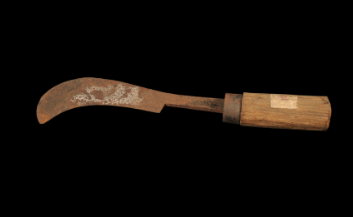State
Tribe Name
Art Type
short description
The dao is a traditional tool representing indigenous culture and craftsmanship of the Santal tribe, which stands as one of the largest tribal communities in eastern India. The dao is primarily meant for domestic purposes and constitutes an iron double-edged blade with a convex cutting face mounted on a wooden handle of short length. The blade has a short tang that is fitted in the wooden handle; at the joint, a metal ferrule is placed to enhance strength and durability.
Thumbnail

Filter Postion
Left
Filter Background
Off
Theme
Filter Header Image

content
Image

description
The dao is a traditional tool representing indigenous culture and craftsmanship of the Santal tribe, which stands as one of the largest tribal communities in eastern India. The dao is primarily meant for domestic purposes and constitutes an iron double-edged blade with a convex cutting face mounted on a wooden handle of short length. The blade has a short tang that is fitted in the wooden handle; at the joint, a metal ferrule is placed to enhance strength and durability.
This instrument is mainly for household chores like cutting vegetables, chopping wood, and farming work, while the curved design lends itself to ease of slicing action associated with household work. The curved blade design has made this household instrument effective and reliable. The knowledge of making such tools, which are at hand, is one that the Santal considers one of the prime aspects of its craftsmanship, and this is said to bear witness to an understanding of metallurgy and ergonomics taught for generations.
Primarily, the Santal tribe, found in Jharkhand, Odisha, Bengal, and Bihar, throw from those tight groups of persons, worshipping nature and cherishing their traditions. Tools and Artefacts made by such people are generally handmade, employing resources available in the immediate vicinity, thus indicating their sustainable outlook towards life and a deep-rooted connection with nature.
This instrument is mainly for household chores like cutting vegetables, chopping wood, and farming work, while the curved design lends itself to ease of slicing action associated with household work. The curved blade design has made this household instrument effective and reliable. The knowledge of making such tools, which are at hand, is one that the Santal considers one of the prime aspects of its craftsmanship, and this is said to bear witness to an understanding of metallurgy and ergonomics taught for generations.
Primarily, the Santal tribe, found in Jharkhand, Odisha, Bengal, and Bihar, throw from those tight groups of persons, worshipping nature and cherishing their traditions. Tools and Artefacts made by such people are generally handmade, employing resources available in the immediate vicinity, thus indicating their sustainable outlook towards life and a deep-rooted connection with nature.
Image Mode
landscape
promoted
On
Verified
Off
